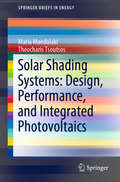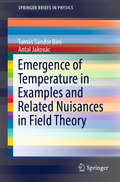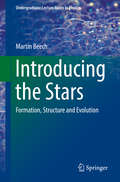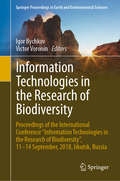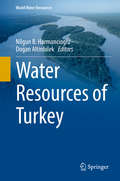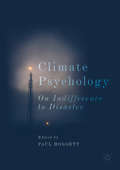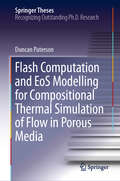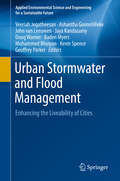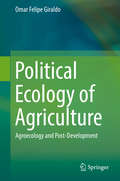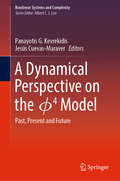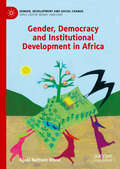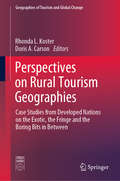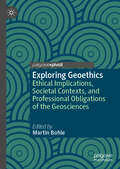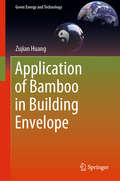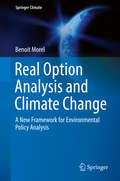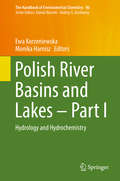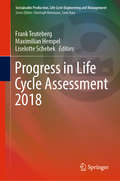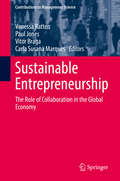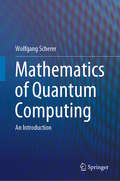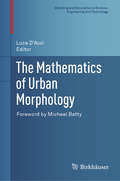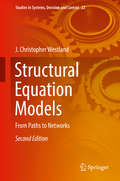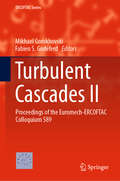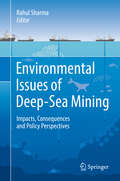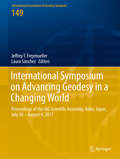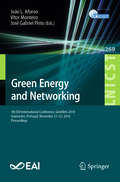- Table View
- List View
Solar Shading Systems: Design, Performance, and Integrated Photovoltaics (SpringerBriefs in Energy)
by Maria Mandalaki Theocharis TsoutsosThis is the first book to describe the development of and state of the art in solar shading devices in buildings, detailing all methods of evaluating shading systems according to thermal and visual comfort. The issue of energy balance in buildings is gaining importance as conventional energy sources dwindle and become more expensive. As such, environmental concerns should be considered in overall design decisions. The book discusses the role sun control “machines” play in controlling solar and thermal radiation. It examines their geometry, their position in relation to glazing and their operation (in the cases of movable systems) to control the heat and light entering a building, as well as how their material and color influence their performance. This book appeals to architects and designers who are interested in efficient energy facade design.
Emergence of Temperature in Examples and Related Nuisances in Field Theory (SpringerBriefs in Physics)
by Antal Jakovác Tamás Sándor BiróField theory, relying on the concept of continuous space and time while confronted with the quantum physical nature of observable quantities, still has some fundamental challenges to face. One such challenge is to understand the emergence of complexity in the behavior of interacting elementary fields, including among other things nontrivial phase structures of elementary matter at high energy density or an atypical emergence of statistical properties, e.g., when an apparent temperature is proportional to a constant acceleration in a homogeneous gravitational field. Most modern textbooks on thermal field theory are mainly concerned with how the field theory formalism should be used if a finite temperature is given. In contrast, this short primer explores how the phenomenon of temperature emerges physically for elementary fields - inquiring about the underlying kinetic field theory and the way energy fluctuations and other noise should be handled - and it investigates whether and how this harmonizes with traditional field theory concepts like spectral evolution, the Keldysh formalism, and phase transitions.
Introducing the Stars: Formation, Structure and Evolution (Undergraduate Lecture Notes in Physics)
by Martin BeechThis textbook introduces the reader to the basic concepts and equations that describe stellar structure. Various approximation techniques are used to solve equations, and an intuitive rather than rigorous approach is employed to interpret the properties of the stars. The book provides step-by-step instructions, helpful exercises and relevant historical lessons to familiarize students with key concepts and mathematical theories.Based upon a series of one-semester (12 weeks) elective undergraduate courses offered at the University of Regina, this book is intended for students who are interested in seeing how basic calculus and introductory physics can be applied to the understanding of the stars from their formation to their death. The text provides an intermediate stepping stone between lower-level undergraduate classes and more specialized postgraduate texts on the subject of stellar structure.
Information Technologies in the Research of Biodiversity: Proceedings of the International Conference "Information Technologies in the Research of Biodiversity", 11–14 September, 2018, Irkutsk, Russia (Springer Proceedings in Earth and Environmental Sciences)
by Igor Bychkov Victor VoroninThis book offers a collection of papers presented at the First International Conference” Information Technologies in the Research of Biodiversity” that was held from 11-14 September 2018 in Irkutsk (Russia). Papers in this book cover areas of interaction of knowledge on biodiversity and information technologies. The main topics include: methods, models, software systems for the analysis of biodiversity data; global data portals; information and analytical systems on biodiversity; application of remote methods in vegetation mapping; theoretical fundaments and organization technologies of the information and telecommunications infrastructures.
Water Resources of Turkey (World Water Resources #2)
by Nilgun B. Harmancioglu Dogan AltinbilekThis book provides an in-depth description of water resources of Turkey, a country with a unique geographical location, extending from the Mediterranean in Europe to the Middle East. Its varying geography, topography, hydrology, geology and climate are reflected in the diverse characteristics of its water basins. Furthermore, due to its geographical location, Turkey has a significant number of transboundary river basins and has to share its water resources with its neighbors, an issue that can sometimes lead to water conflicts.Turkey is also an interesting example of a developing country that is attempting to adapt to universal water management strategies while at the same time facing legal, institutional, economic and capacity development problems. It has long remained a water-rich country, but the situation is now changing due to the increasing population, inefficient use of resources, and the impacts of climate change and environmental degradation.This book is useful for national and international organizations as well as water resources professionals. It takes on an added significance in the light of climate change in the region, water management problems and transboundary water basins.
Climate Psychology: On Indifference to Disaster (Studies in the Psychosocial)
by Paul HoggettThis book investigates the psycho-social phenomenon which is society’s failure to respond to climate change. It analyses the non-rational dimensions of our collective paralysis in the face of worsening climate change and environmental destruction, exploring the emotional, ethical, social, organizational and cultural dynamics to blame for this global lack of action. The book features eleven research projects from four different countries and is divided in two parts, the first highlighting novel methodologies, the second presenting new findings. Contributors to the first part show how a ‘deep listening’ approach to research can reveal the anxieties, tensions, contradictions, frames and narratives that contribute to people’s experiences, and the many ways climate change and other environmental risks are imagined through metaphor, imagery and dreams. Using detailed interview extracts drawn from politicians, scientists and activists as well as ordinary people, the second part of the book examines the many different ways in which we both avoid and square up to this gathering disaster, and the many faces of alarm, outrage, denial and indifference this involves.
Flash Computation and EoS Modelling for Compositional Thermal Simulation of Flow in Porous Media (Springer Theses)
by Duncan PatersonThis book investigates a wide range of phase equilibrium modelling and calculation problems for compositional thermal simulation. Further, it provides an effective solution for multiphase isenthalpic flash under the classical framework, and it also presents a new flash calculation framework for multiphase systems, which can handle phase equilibrium and chemical reaction equilibrium simultaneously. The framework is particularly suitable for systems with many phases and reactions. In this book, the author shows how the new framework can be generalised for different flash specifications and different independent variables. Since the flash calculation is at the heart of various types of compositional simulation, the findings presented here will promote the combination of phase equilibrium and chemical equilibrium calculations in future simulators, aiming at improving their robustness and efficiency.
Urban Stormwater and Flood Management: Enhancing the Liveability of Cities (Applied Environmental Science and Engineering for a Sustainable Future)
by Veeriah Jegatheesan Ashantha Goonetilleke John Van Leeuwen Jaya Kandasamy Doug Warner Baden Myers Muhammed Bhuiyan Kevin Spence Geoffrey ParkerThis book brings together the experiences of engineers and scientists from Australia and the United Kingdom providing the current status on the management of stormwater and flooding in urban areas and suggesting ways forward. It forms a basis for the development of a framework for the implementation of integrated and optimised storm water management strategies and aims to mitigate the adverse impacts of the expanding urban water footprint. Among other topics it also features management styles of stormwater and flooding and describes biodiversity and ecosystem services in relation to the management of stormwater and the mitigation of floods. Furthermore, it places an emphasis on sustainable storm water management measures. Population growth, urbanisation and climate change will pose significant challenges to engineers, scientists, medical practitioners, policy makers and practitioners of several other disciplines. If we consider environmental and water engineers, they will have to face challenges in designing smart and efficient water systems which are robust and resilient to overcome shrinking green spaces, increased urban heat islands, damages to natural waterways due to flooding caused by increased stormwater flow. This work provides valuable information for practitioners and students at both senior undergraduate and postgraduate levels.
Political Ecology of Agriculture: Agroecology and Post-Development
by Omar Felipe GiraldoThis study discusses an original proposal aimed at critically analyzing the power relations that exist in contemporary agriculture. The author endeavors herein to clarify some of the strategies that industrial agribusiness, in collusion with the state and multilateral structures, sets in motion in order to functionalize the lives of millions of farmers, so that their bodies, enunciations, and sensibilities can be repurposed in accordance with the dynamics of capital accumulation. The argument is based on the idea that agro-extractivism cannot be thought of exclusively as an economic-political and technological system, but as a complex interweaving of cultural meanings, aesthetics, and affections, which, amalgamated under the abstract name of "development", act as a support for the whole system's scaffolding. The book also explores the other side of the coin, describing how, and under what conditions, social movements are responding to the calamities generated by this model. The central thesis is that many ongoing agroecological processes are providing one of the most interesting guidelines at present for visualizing transitions towards post-development, post-extractivism, and the construction of multiple worlds beyond the sphere of capital. Political ecology of agriculture joins the calls that question the cultural project of modernity and the predatory sense imposed by the globalized food empire, and invites recognition of the importance of agroecology in the context of the end of the fossil-fuel era and the likely collapse of our industry-based civilization.
A Dynamical Perspective on the ɸ4 Model: Past, Present and Future (Nonlinear Systems and Complexity #26)
by Panayotis G. Kevrekidis Jesús Cuevas-MaraverThis book presents a careful selection of the most important developments of the \phi^4 model, offering a judicious summary of this model with a view to future prospects and the challenges ahead. Over the past four decades, the \phi^4 model has been the basis for a broad array of developments in the physics and mathematics of nonlinear waves. From kinks to breathers, from continuum media to discrete lattices, from collisions of solitary waves to spectral properties, and from deterministic to stochastic models of \phi^4 (and \phi^6, \phi^8, \phi^12 variants more recently), this dynamical model has served as an excellent test bed for formulating and testing the ideas of nonlinear science and solitary waves.
Gender, Democracy and Institutional Development in Africa (Gender, Development and Social Change)
by Njoki Nathani WaneThis book analyses African foundations of gender, education, politics, democracy and institutional development by stimulating theoretical discourses. It offers a discursive framework on ways to examine the conceptualizations of African social development and a critical discourse on debunking the misconceptions that are attached to African location in the global arena. The volume challenges the danger of minimizing and oversimplifying the role of Africa in the international space. This will be ideal for researchers, students and scholars in the areas of African and gender studies, development, politics and education.
Perspectives on Rural Tourism Geographies: Case Studies from Developed Nations on the Exotic, the Fringe and the Boring Bits in Between (Geographies of Tourism and Global Change)
by Rhonda L. Koster Doris A. CarsonThis book examines rural tourism across three different contexts, acknowledging the complexity of rural places. It applies a systematic comparative framework across nine case studies from Australia, Canada and Sweden. The case studies address the uniqueness of different rural spaces, while the framework incorporates many theoretical aspects from human geography including spatial, historic, institutional, demographic, socio-economic and network perspectives. In the course of applying this comparative case study framework, the book identifies numerous implications for planning and policy in rural settings. These contributions from international, expert authors help to identify the opportunities and challenges that affect rural regions, from places at the urban fringe to exotic remote spaces and taking in the ‘boring bits in between.’ Both the analysis and the framework used will be of value to scholars and students of rurality, tourism, regional development, rural policy, geography, and destination management. Readers will gain a deeper understanding of the rural context in developed countries and a robust conceptualization of rural tourism geographies.
Exploring Geoethics: Ethical Implications, Societal Contexts, and Professional Obligations of the Geosciences
by Martin BohleThis book explores the potential of geoethics, as designed within the operational criteria of addressing the deeds and values of the human agent as part of the Earth system. It addresses three key questions: i) what should be considered 'geoethics' in an operational sense, ii) what is peripheral to it, and iii) is there a case therefore to establish a denomination, such as geo-humanities or geosophy, to capture a broader scope of thinking about geoscience and its interactions with society and the natural world, for the benefit of the geo-professionals and others.The book begins by framing, contextualising and describing contemporary geoethics, then goes on to cover several examples of geoethical thinking and explores the societal intersections of geosciences in the planetary ‘human niche’. The concluding chapter discusses the challenges facing the emerging field of geoethics and how it may evolve in the future. Bringing together a set of experts across multiple interdisciplinary fields this collection will appeal to scholars, researchers, practitioners and students within geosciences and social sciences, political sciences as well as the humanities. It will interest those who are curious about how ethical reflections relate to professional duties, scholarly interests, activities in professional geoscience associations, or responsible citizenship in times of anthropogenic global change.
Application of Bamboo in Building Envelope (Green Energy and Technology)
by Zujian HuangThis book offers a comprehensive overview of the use of bamboo in building industry. It systematically demonstrates bamboo’s utility in terms of its properties, describing the material properties of typical industrial bamboo products, and discussing their performance evaluation and optimization as building components and in the creation of building envelopes. The book also includes examples of the high-value utilization of bamboo forest resources. Further, it examines how building performance may be affected by conditions such as climate. Including insights from material science, construction design, building physics and building climatology, the book also provides data obtained from technology and market status investigation, laboratory test and the computer simulation.This book appeals to scientists and professionals, as it introduces and tests various bamboo products, demonstrating the advantages and disadvantages for each one. The book is also a valuable resource for civil engineers and students interested in this unique plant material and its application in the building industry.
Real Option Analysis and Climate Change: A New Framework for Environmental Policy Analysis (Springer Climate)
by Benoit MorelThis book sets out to reframe the theory of real options so that it can be used to support environmental investments for climate change adaptation and mitigation. Climate change policy often involves making decisions that concern extended time periods, and doing so under considerable uncertainty. By expanding and broadening the framework of real options, this book first introduces readers to new ways of quantifying investment decisions that can much more effectively address the shape and size of the uncertainty than traditional approaches using Net Present Value. In turn, the second part of the book applies this new theoretical framework to climate change policy by presenting a number of examples, and by providing a general perspective on investment decisions related to climate change and how to prioritize them.
Polish River Basins and Lakes – Part I: Hydrology and Hydrochemistry (The Handbook of Environmental Chemistry #86)
by Ewa Korzeniewska Monika HarniszThis book offers a comprehensive review of the current environmental conditions and chemical changes in Polish surface waters. Poland is situated in an area that was covered by glaciations in the distant past. The subsequent periods of glacial advance and retreat produced a continuous rejuvenation of the landscape, and the discharge of surplus water from this area was constantly transformed by morphological, climatic and hydrological changes. Written by expert contributors, the book’s respective chapters address the impact of current climatic conditions on the functioning of surface water reservoirs in Poland, while also exploring the country’s hydrographic and hydrological network and the trophic state of its rivers and lakes, their eutrophication and threats. Particular attention is paid to sources of pollution, above all, the chemical pollution of water and sediments. Together with the companion book Polish River Basins and Lakes – Part II: Biological Status and Water Management, it provides students, environmental chemists, biologists, geologists, hydrologists and surface waters managers with authoritative information on Poland’s current environmental status.
Progress in Life Cycle Assessment 2018 (Sustainable Production, Life Cycle Engineering and Management)
by Frank Teuteberg Maximilian Hempel Liselotte SchebekThis book comprises recent developments in life cycle assessment (LCA) both with regards to the methodology and its application in various research fields, including mobility, engineering and manufacturing. Containing numerous original research articles from leading German research institutes, the book provides an insightful resource for professionals working in the field of sustainability assessment, for researchers interested in the current state of LCA research as well as for advanced university students in different scientific and engineering fields.
Sustainable Entrepreneurship: The Role Of Collaboration In The Global Economy (Contributions to Management Science)
by Paul Jones Vanessa Ratten Vitor Braga Carla Susana MarquesSustainable entrepreneurship focuses on how the environment is embedded within business practices. This book examines collaboration strategies and initiatives for sustainable entrepreneurs with a wide variety of partners, and demonstrates how they can be used to increase overall performance and achieve global competitiveness. Based on the latest empirical evidence from emerging economies, the book’s respective chapters address sustainability issues in connection with knowledge creation and learning, outsourcing, and the roles of universities, consultants, and the public sector.
Mathematics of Quantum Computing: An Introduction
by Wolfgang SchererThis textbook presents the elementary aspects of quantum computing in a mathematical form. It is intended as core or supplementary reading for physicists, mathematicians, and computer scientists taking a first course on quantum computing. It starts by introducing the basic mathematics required for quantum mechanics, and then goes on to present, in detail, the notions of quantum mechanics, entanglement, quantum gates, and quantum algorithms, of which Shor's factorisation and Grover's search algorithm are discussed extensively. In addition, the algorithms for the Abelian Hidden Subgroup and Discrete Logarithm problems are presented and the latter is used to show how the Bitcoin digital signature may be compromised. It also addresses the problem of error correction as well as giving a detailed exposition of adiabatic quantum computing. The book contains around 140 exercises for the student, covering all of the topics treated, together with an appendix of solutions.
The Mathematics of Urban Morphology (Modeling and Simulation in Science, Engineering and Technology)
by Michael Batty Luca D'AcciThis edited volume provides an essential resource for urban morphology, the study of urban forms and structures, offering a much-needed mathematical perspective. Experts on a variety of mathematical modeling techniques provide new insights into specific aspects of the field, such as street networks, sustainability, and urban growth. The chapters collected here make a clear case for the importance of tools and methods to understand, model, and simulate the formation and evolution of cities.The chapters cover a wide variety of topics in urban morphology, and are conveniently organized by their mathematical principles. The first part covers fractals and focuses on how self-similar structures sort themselves out through competition. This is followed by a section on cellular automata, and includes chapters exploring how they generate fractal forms. Networks are the focus of the third part, which includes street networks and other forms as well. Chapters that examine complexity and its relation to urban structures are in part four.The fifth part introduces a variety of other quantitative models that can be used to study urban morphology. In the book’s final section, a series of multidisciplinary commentaries offers readers new ways of looking at the relationship between mathematics and urban forms.Being the first book on this topic, Mathematics of Urban Morphology will be an invaluable resource for applied mathematicians and anyone studying urban morphology. Additionally, anyone who is interested in cities from the angle of economics, sociology, architecture, or geography will also find it useful."This book provides a useful perspective on the state of the art with respect to urban morphology in general and mathematics as tools and frames to disentangle the ideas that pervade arguments about form and function in particular. There is much to absorb in the pages that follow and there are many pointers to ways in which these ideas can be linked to related theories of cities, urban design and urban policy analysis as well as new movements such as the role of computation in cities and the idea of the smart city. Much food for thought. Read on, digest, enjoy." From the foreword by Michael Batty
Structural Equation Models: From Paths to Networks (Studies in Systems, Decision and Control #22)
by J. Christopher WestlandThis new edition surveys the full range of available structural equation modeling (SEM) methodologies. The book has been updated throughout to reflect the arrival of new software packages, which have made analysis much easier than in the past. Applications in a broad range of disciplines are discussed, particularly in the social sciences where many key concepts are not directly observable. This book presents SEM’s development in its proper historical context–essential to understanding the application, strengths and weaknesses of each particular method. This book also surveys the emerging path and network approaches that complement and enhance SEM, and that are growing in importance. SEM’s ability to accommodate unobservable theory constructs through latent variables is of significant importance to social scientists. Latent variable theory and application are comprehensively explained and methods are presented for extending their power, including guidelines for data preparation, sample size calculation and the special treatment of Likert scale data. Tables of software, methodologies and fit statistics provide a concise reference for any research program, helping assure that its conclusions are defensible and publishable.
Turbulent Cascades II: Proceedings of the Euromech-ERCOFTAC Colloquium 589 (ERCOFTAC Series #26)
by Mikhael Gorokhovski Fabien S. GodeferdGathering contributions by the most prominent researchers in a highly specialised field, this proceedings volume clarifies selected aspects of the physics of turbulent cascades and their statistical universalities under complex stationary and non-homogeneous conditions. Here, these conditions are induced by the presence of a gas/liquid interface, inertial particles, strong shear, rotation, MHD and stratification. By proposing different ways to model turbulence effects under these complex conditions, the book will be of considerable interest not only to academic researchers, but also to specialists and junior researchers in the domain of propulsion and power, as well as those whose work involves various applications related to atmospheric, oceanic and planetary physics.
Environmental Issues of Deep-Sea Mining: Impacts, Consequences and Policy Perspectives
by Rahul SharmaThis volume discusses environmental issues associated with deep-sea mining, with an emphasis on potential impacts, their consequences and the policy perspectives. The book describes the methods and technologies to assess, monitor and mitigate mining impacts on marine environments, and also suggests various approaches for environmental management when conducting deep-sea mining. The volume brings together information and data for researchers, contractors, mining companies, regulators, and NGOs working in the field of deep-sea mining. Section 1 highlights the various environmental issues and discusses methods and approaches that can help in developing environmentally sustainable deep-sea mining. Section 2 details the results and outcomes of studies related to impact assessment of deep-sea mining, and proposes methods for monitoring. Section 3 discusses the need and means for developing data standards and their application to deep-sea mining. Section 4 discusses the policies, approaches, and practices related to deep-sea mining, suggests formats for developing environmental impact statements (EIS) and environmental management plans (EMP), and describes national and international regulations for environmental management. Section 5 concludes the text by putting deep-sea economic activities into an environmental context and conducting techno-economic analyses of deep-sea mining and processing.
International Symposium on Advancing Geodesy in a Changing World: Proceedings of the IAG Scientific Assembly, Kobe, Japan, July 30 – August 4, 2017 (International Association of Geodesy Symposia #149)
by Jeffrey T. Freymueller Laura SánchezThese proceedings contain 23 papers, which are the peer-reviewed versions of presentations made at the Joint Scientific Assembly of the International Association of Geodesy (IAG) and the International Association of Seismology and Physics of the Earth’s Interior (IASPEI). The assembly was held from 30 July to 4 August 2017 in Kobe, Japan. The scientific assembly included seven symposia organized by IAG, and nine joint symposia, along with additional symposia organized by IASPEI. The IAG symposia were structured according to the four IAG Commissions and the three GGOS Focus Areas, and included reference frames, static and time-variable gravity field, Earth rotation and geodynamics, multi-signal positioning, geodetic remote sensing, and GGOS. The joint symposia included monitoring of the cryosphere, studies of earthquakes, earthquake source processes, and other types of fault slip, geohazard warning systems, deformation of the lithosphere, and seafloor geodesy. Together, the IAG and joint symposia spanned a broad range of work in geodesy and its applications.
Green Energy and Networking: 5th EAI International Conference, GreeNets 2018, Guimarães, Portugal, November 21–23, 2018, Proceedings (Lecture Notes of the Institute for Computer Sciences, Social Informatics and Telecommunications Engineering #269)
by José Gabriel Pinto Vítor Monteiro João L. AfonsoThis book constitutes the refereed post-conference proceedings of the 5th EAI International Conference on Green Energy and Networking, GreeNets 2018, held in Guimarães, Portugal, in November 2018. The 15 full papers were selected form 26 submissions and cover a wide spectrum of ideas to reduce the impact of the climate change, while maintaining social prosperity. In this context, growing global concern leads to the adoption of the new technological paradigms, especially for the operation of future smart cities.
